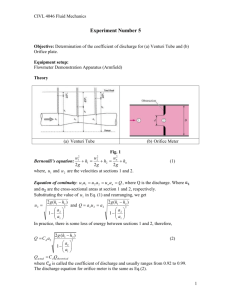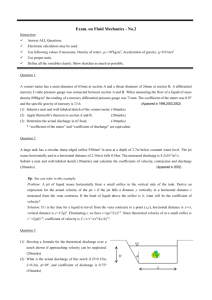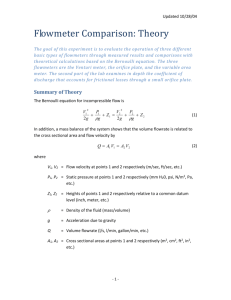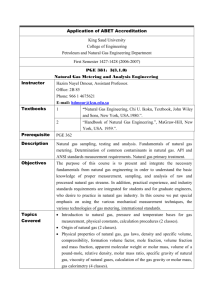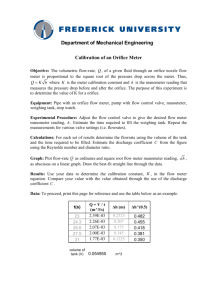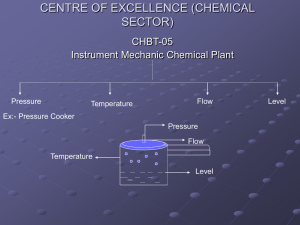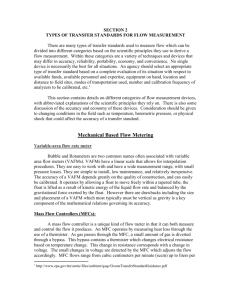Reference - MyMathDone
advertisement
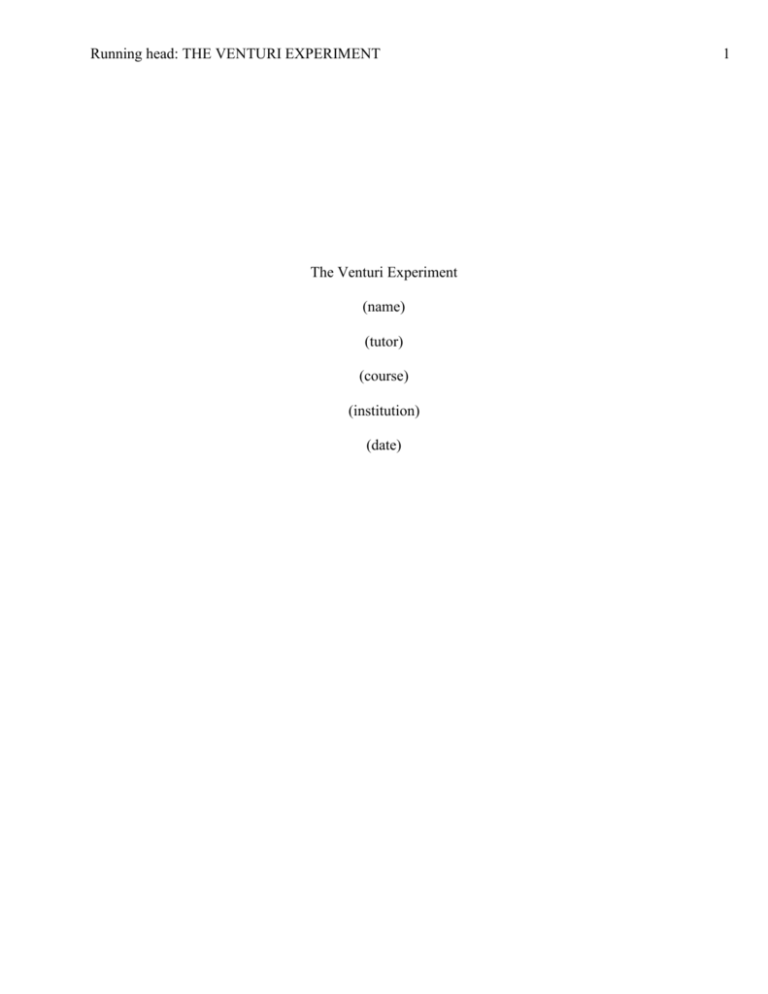
Running head: THE VENTURI EXPERIMENT The Venturi Experiment (name) (tutor) (course) (institution) (date) 1 THE VENTURI EXPERIMENT 2 Abstract The purpose of this experiment was to determine the overall meter coefficient foe an orifice plate and a venture meter. Also of interest was to consider the application of these meters in engineering flow measurement. The procedure involved the use of a hydraulic bench, an orifice meter and a venture meter. The mean value of the coefficient of discharge for the venture meter was found to be 0.99916 while that of the orifice was 5.47. From this result, it was concluded that the orifice meter encounters more losses compared to the venture meter. Therefore, the venture meter is more efficient. Introduction The flow meters are used to measure the rate at which fluids flow in pipes. They are mainly used in industries. The head flow meters measure the flow rate by using a constriction in the path of the fluid flow. The Bernoulli’s theorem is then used to determine the flow rate by comparing the pressure difference between the point of the constriction and the other points which are not constricted. When a constriction occurs in a pipe through which fluids flow, velocity of the fluid increases at the point of the constriction. This will intern result in an increase in the kinetic energy that the fluid possessed. When the velocity of the fluid increases, its pressure reduces. Therefore, the pressure at the point of the constriction is lower. The coefficient of discharge is a ratio. It is found by comparing the actual flow of the fluid to the theoretical flow. The venturi meter and the orifice meter are used when measuring the flow of fluids in enclosed channels (Giles, Evett, & Liu, 2009). The losses in terms of pressure for the venture meter are less. Therefore, they are used when the volume of the fluid is large. The calibration of the meters is necessary to ensure that correct measurements are taken. For analysis purposes, it is assumed that THE VENTURI EXPERIMENT 3 the flow in the pipes is steady, frictionless and along a streamline. The fluid is also considered to be incompressible. The orifice meter consists of a flat plate. The plate has a hole that is drilled at the center. The meter also contains flanges which are perpendicular to the flow of the fluid. The plate lies between the flanges. The Bernoulli’s equation showing the relationship between the flow rate and the pressure drop is shown below: Where Q is the flow rate, A is the cross sectional area of the orifice, C is the coefficient of discharge, P1 and P2 are the pressures at the two ends of the orifice and β represents the relationship between the diameter of the orifice and that of the pipe. The venturi meter consists of sections that contract and expand. The contraction and expansion is smooth. The difference in pressure between these regions can be correlated to the flow rate of the fluid. By applying the continuity equation and the energy equation, the theoretical flow rate can be determined. Equation (i) shown earlier can also be used for the case of a venture meter to calculate the flow rate. The diagram below shows an orifice meter and a venture meter: THE VENTURI EXPERIMENT 4 Figure 1 An orifice and a venture meter Apparatus The apparatus used in this experiment include: i. Hydraulic bench ii. Orifice meter iii. Venturi meter The venturi meter is a long section that gradually converges. The throat appears at this convergent section. A long diverging section then follows the throat. The orifice plate, on the other hand, is made of a brass plate. The plate has a hole through which fluids flow through. The meter is mounted between two flanges. These flanges are pressure tapped. The measurement of pressure in these apparatus is done at various points. These include the venture entry, venture throat, venture exit, tapped flanges and the orifice entry. All the apparatus used to measure the flow rate are connected to the hydraulic bench water supply. Procedure The apparatus used in the experiment were observed on a hydraulic bench. The inlet valve on the hydraulic bench was opened slowly. This was done after the pump was switched on. Before starting the experiment, the air that was in the system was removed. This was done by closing the flow control valve. The air bleed screw was then opened. The prime manometer and the tapping were also opened to release the air that was in the system. The pump was then switched off. The levels of the manometers were adjusted by adjusting the air bleed screw. This was to ensure that a comfortable level is obtained on the manometer such that there was enough room for the water column. This was vital since during the experiment the water column moves up and down. After establishing an appropriate water level, the air bleed screw was closed. The THE VENTURI EXPERIMENT 5 pump was then switched on. The inlet and the outlet valves were adjusted to ensure that a steady flow rate (Q) is obtained. The volume of the reservoir of water was also measured. The time that is taken to fill the portion of the reservoir was measured by a stop watch. The value of the difference between the manometer arms (pressure difference) for both the orifice and venture meter was measured and recorded. This procedure was repeated to ensure that a wide range of flow rates (Q) were recorded. The manual for the meters was followed to endure that the meters were not destroyed. Results and calculations The results that were obtained during the experiment were tabulated. The value of the coefficient of discharge for each flow rate was determined and recorded in the table. The calculation of the values for test 1 is shown below: Average time Flow rate For the venturi meter THE VENTURI EXPERIMENT 6 For the orifice meter The other values of the coefficient of discharge were calculated as shown earlier. They were then recorded in the tables shown below: Table 1 Results Results Venturi Orifice D2= 20 D1= 51 D2= 16 D1= 26 Test Mass (kg) Time (S) Q (m3/s) H1 (mm) H2 (mm) H1 (mm) H2 (mm) 1 6 11.78 0.00051 379 80 173 31 0.00047 351 109 133 61 0.00042 329 331 133 23 0.00038 311 332 106 332 0.00032 391 373 327 332 11.75 3 6 12.91 33.23 1 6 14.31 14.25 3 6 15.54 15.88 5 6 18.68 THE VENTURI EXPERIMENT 7 18.88 6 6 24.53 0.00025 268 313 361 24.37 Table 2 Calculations Calculations Venturi ∆h (m) Orifice C ∆h (m) C Test Mass (kg) Time (S) (h1-h2) (h1-h2) 1 6 11.78 0.229 1.114 0.348 6.145 0.242 0.998 0.281 6.302 0.2 0.981 0.242 6.069 0.163 0.984 0.188 6.229 0.22 0.713 0.139 6.101 0.074 1.205 0.81 1.974 11.75 3 6 12.91 33.23 1 6 14.31 14.25 3 6 15.54 15.88 5 6 18.68 18.88 6 6 24.53 24.37 Analysis and discussion 323 THE VENTURI EXPERIMENT 8 The mean value of the coefficient of discharge for the venture meter is 0.99916 while that of the orifice is 5.47. The value of the coefficient of discharge for both the meters is dependent on the value of the discharge. When the discharge was reduced, for the venture meter, the coefficient of discharge also decreased until a point where the value increased again. The orifice meter showed interchanging outcomes as the flow rate reduced. The coefficient of discharge value did not exhibit a particular trend. Generally, this value reduced with the reduction in the flow rate. The coefficient of discharge for the venturi meter was found to be greater than that of the orifice. This means that the losses that are encountered in the orifice meter is larger than those which are incurred in the case of the venturi meter. These losses are referred to as head loss. The value of the head loss increases as the discharge increases. The data also indicates that the application of the orifice meter is more economical compared to the venture meter. However, the venture meter gives more accurate results since its head loss is smaller. This means that the choice of the meter to use depends on the accuracy needed and also on the financial state of the company that intends to implement the use of the flow meters. There are errors that were encountered during the experiment. These may be attributed to parallax, systematic errors and errors due to the aging of the equipment used. Parallax is the error during taking of the measurements. If the viewing angle is wrong, then the data that will be obtained will also be faulty. In this case, they may have been transmitted to the data while taking the readings of the manometers. The other type of error is the systematic error. This is the error that is within the measuring instrument. It includes the zero error, the error as a result of printing on the measuring instrument or error that is as a result of temperature changes which affect the THE VENTURI EXPERIMENT 9 measuring instrument. These errors contribute to the value being obtained deviating from the actual value. Conclusion The experiment was a success since the value of the coefficient of discharge was determined. This value is 0.99916 for the venture meter and 5.47 for the orifice meter. The value of the coefficient of discharge was found to depend on the flow rate. An increase in the flow rate resulted in a corresponding increase in the coefficient of discharge. There were errors that were encountered during the experiment and they resulted in the coefficient of discharge value for both the orifice meter and the venture meter deviating from the actual value. THE VENTURI EXPERIMENT 10 Reference Giles, R., Evett, J., & Liu, C. (2009). Schaum's Outline of Fluid Mechanics and Hydraulics. New York: McGraw Hill.
